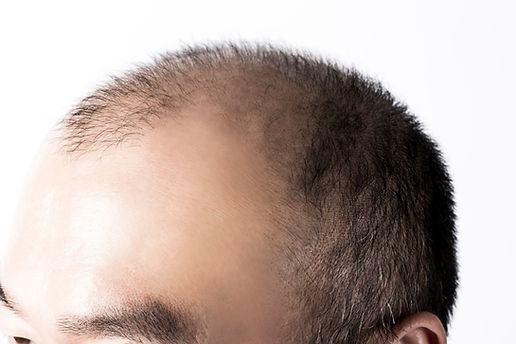PRP for Androgenetic Alopecia
Androgenetic alopecia (AGA) is the most common type of hair loss, characterized by a hair follicles miniaturization, possibly due to increased levels of dihydrotestosterone (DHT) and/or alterations in the androgen receptor gene. These progressive follicular changes lead to a decreased number of hairs in the anagen phase, such that terminal follicles convert into vellus-like follicles.
A unique procedure is being performed at Lessage Laser Spa. It is called PRP + PDRN therapy and is based on the ability of our body's cells to self-regenerate that helps to repair damaged skin cells and stimulate collagen production.

PRP for Alopecia Areata
Alopecia areata (AA, also referred to as spot or patch baldness) is an autoimmune hair loss condition where the immune system attacks actively growing hair follicles. This condition commonly occurs on the scalp but may involve other facial or body hairs and affects both men and women.
A unique procedure is being performed at Lessage Laser Spa. It is called PRP + Triamcinolone Acetonide and is based on the ability of our body's cells to self-regenerate that helps to repair damaged skin cells and stimulate collagen production. Microneedling cause small pinpoint wounds. Advancements in molecular research have led to the identification of numerous proteins and genes which get stimulated on wounding, namely vascular endothelial growth factor, β-catenin, Wnt3a and Wnt3b [5].

PRP for Cicatricial Alopecia
Cicatricial alopecia (scarring alopecia) is a rarer class of hair loss comprised of several different and often overlapping conditions such as central centrifugal cicatricial alopecia (CCCA), lichen planopilaris (LPP), frontal fibrosing alopecia (FFA), traction alopecia, etc. All of these diseases result in follicular damage and eventually permanent replacement with fibrous tissue. Histopathological diagnosis and management of scarring alopecia can be challenging with the primary goal of minimizing inflammation and preserving existing hairs. Restoration options, such as hair transplantation and tissue expansion techniques, can be limited and are only considered after scarring has become fixed.
PRP may be of value in these hair loss patients, as it has both regenerative and anti-inflammatory properties.
PRP may be advantageous following surgical hair restoration procedures.
PRP with Surgical Hair Restoration
Follicular unit transplantation (FUT) and follicular unit extraction (FUE) are the main hair transplant options available to AGA patients. During FUT, hair follicles are obtained through the surgical removal of a hairbearing strip from the back of the scalp. As an alternative to FUT, follicular units can be harvested individually from the donor region using the FUE harvesting technique. During both FUE and FUT, hair follicles are subject to injury or dehydration and thus, less viable. Graft storage solutions containing activated platelets could help with graft preservation and encourage grafts to enter the anagen (growth) phase prior to implantation.
Prior to FUT, PRP is recommended as a 15% increase in hair growth and hair density was reported.

PRP treatment for seborrheic dermatitis
(dandruff, dryness, itching)
Seborrheic Dermatitis is a chronic condition which causes excessive flakiness and an underline greasy skin, these areas usually itch. This commonly effects the scalp which results in severe dandruff.
Seborrheic Dermatitis does not usually cause hair loss, however after excessive rubbing and scratching it can damage the hair follicle causing it to fall out.
Initially, seborrheic dermatitis may take the form of a red, itchy scalp and flakes of skin showing in your hair.
As it worsens you will start to see lots more flakes of skin appearing, inflammation on your scalp and patches of greasy white or even yellow skin. These patches of skin are not just focussed on your scalp, you may notice them on your face, nose, eyelids, chest or armpits.
PRP treatment is an option for seborrheic dermatitis. If hair loss occurs due to this condition, either due to excessive scratching or overgrowth of Malassezia, it is only temporary, hair growth regrows usually when the inflammation resolves, this may be the basis of why PRP works.


